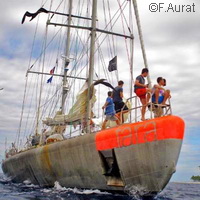Major study maps marine biodiversity
Members of the TARA OCEANS expedition will finally anchor in Lorient, France on 31 March, bringing a 28-month, 60 000-mile journey to a close. Researchers on board the vessel collected and investigated samples of microorganisms from the major oceans of our planet. The study was highlighted in an editorial in the journal Molecular Systems Biology, authored by Eric Karsenti of the European Molecular Biology Laboratory (EMBL) in Heidelberg, Germany. 'Life and evolution started in the oceans, yet we know very little about the distribution of marine biodiversity,' said Dr Karsenti, the co-director of the TARA OCEANS project. 'If it were not for these microorganisms we would not exist. First, we are their evolutionary descendants, and second, they generate the atmosphere of the Earth.' The main aim of the study was to determine the interaction of microscopic organisms with their environment. The team also sought to provide insight on how these complex systems have evolved over time. Data show that microscopic organisms represent 98% of marine life. 'It is an interplay between the different species and each species affects the environment,' Molecular Systems Biology quoted Dr Karsenti as saying in a live podcast. 'Oceans are very heterogeneous both geographically and at different depths - each water mass has a different ecosystem.' Work on this type of project has gained momentum in recent years, due primarily to the advancements made in deoxyribonucleic acid (DNA) sequencing and automated microscopy. Researchers can also develop a global systems biology map of what goes on between the microorganisms and their habitat because powerful data processing methods exist. Systems biology targets the mapping, understanding and modelling of the entire network of interactions that constitute life. 'Systems biology can be applied at any organisational level of living organisms, from molecular interactions to ecosystems and evolution,' Dr Karsenti said. Collecting samples enables scientists to obtain key information on the genetic make-up of the microorganisms found in the planet's oceans and seas. The information also provides insight into microorganisms' shape and physical environment. This information, coupled with real-time satellite imaging of the oceans, gives researchers the tools needed to construct predictive computational models of microorganisms. 'We hope to use the data to feed computational models that will describe the evolution of marine ecosystems,' Dr Karsenti said. 'After the completion of the ocean voyage and the collective phase of the operation, the land-based investigation is truly picking up speed.'For more information, please visit: European Molecular Biology Laboratory (EMBL):http://www.embl.de/Molecular Systems Biology:http://www.nature.com/msbTo listen to the podcast, click: http://www.nature.com/msb/podcasts_videos/index.html(opens in new window)
Countries
Germany



